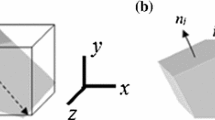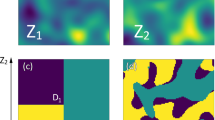Abstract
In this paper, an efficient simulation method for obtaining a random particle model for concrete is outlined. First, the ‘take-and-place method’ and its extension, the ‘directed searching process’, are discussed briefly and the shortcomings are indicated. A new method, the ‘divide-and-fill method’, appears to be more convenient, especially when only a small computer is used. In this simulation method the available space (two-dimensional) is divided in separate areas, using a Delaunay triangulation. These areas are filled with particles taking into account a given grading curve and gravel content. Comparison with physical concrete sections, obtained by means of image analysis, shows that the results of this method closely represent reality. The divide-and-fill method also yields a finite-element mesh in a quasi-automatic way.
Resume
Cette publication traite d’une méthode de simulation efficace pour l’obtention d’un modèle à particules aléatoires pour le béton. On donne d’abord un aperçu de la méthode ‘prenez-et-placez’ et de son extension, la méthode du ‘procédé de placement dirigé’.
La méthode prenez-et-placez produit un modèle numérique à troi dimensions. On réalise la structure composite en plaçant les granulats dans un ordre de grosseur décroissante. Les principles qui sont à l’origine de cette méthode sont d’une simplicité remarquable. Néanmoins on n’obtient de bons résultats qu’à l’aide d’un ordinateur assez puissant, même en considérant le ‘procédé de placement dirigé’. Ce procédé, qui est une forme primaire d’intelligence artificielle, tient compte des zones occupées pour la sélection de la position des granulats.
Une méthode nouvelle qui, de plus, permet l’utilisation d’un PC ordinaire, est la méthode ‘divisez-et-remplissez’. Cette méthode donne un modèle de simulation à deux dimensions et procède en deux étapes. D’abord, on divise la section en triangles de Delaunay. Ensuite, on remplit ces triangles de particules en tenant compte de la distribution granulométrique et de la teneur en gravier. La courbe granulométrique bidimensionnelle peut être calculée facilement à partir de la courbe tridimensionnelle. La triangulation de Delaunay peut être réalisée sur la base d’un algorithme ‘divisez-et-vainquez’, avec un procédé dit ‘bubble’ et contrôle ‘swap’. La méthode divisez-et-remplissez donne quasi automatiquement un maillage d’éléments finis. La géométrie des granulats naturels roulés peut être décrite par une loi morphologique, basée sur la méthode développée par Beddow et Meloy.
Similar content being viewed by others
References
Roelstra, P. E., ‘Der numerische Beton’ (ETH, Lausanne, 1985).
Wittmann, F. H., ‘Herstellen und Eigenschaften des numerischen Betons’, ‘Baustoffe’ 85’ (Bauverlag, Wiesbaden, 1985) pp. 251–255.
Wittmann, F. H., Roelfstra, P. E. and Sadouki, H., ‘Simulation and Analysis of Composite Structures’,Mater. Sci. Eng. 68 (1984–85) 239–248.
Roelfstra, P. E., Sadouki, H. and Wittmann, F. H., ‘Le béton numérique’,Mater. Constr. 18 (1985) 327–335.
Sadouki, H., ‘Simulation et analyse numérique du comportement mécanique de structures composites’, Thèse No. 676, EPF Lausanne (1987).
Roelfstra, P. E., ‘A numerical approach to investigate the properties of concrete; numerical concrete’, Thèse No. 788, EPF Lausanne (1989).
Bazant, Z., Tabbara, M., Kazemi, M. and Pijadier-Cabot, G., Random particle model for fracture of aggregate or fiber composites’,J. Eng. Mech. ASCE No. 8 (August 1990) 1606–1705.
Walraven, J. C., ‘Aggregate interlock: a theoretical and experimental analysis’ (Delft University Press, 1980).
De Schutter, G., ‘Numerieke simulative van de structuur van beton’ (in Dutch), (University of Ghent, 1990).
Guibas, L. and Stolfi, J., ‘Primitives for the manipulation of general subdivisions and the computation of Voronoi diagram’,ACM Trans. Graphics 4, (2) (1985) 74–123.
Beddow, J. K. and Meloy, T., ‘Testing and characterization of powders and fine particles’ (Heyden, London, 1980).
Author information
Authors and Affiliations
Rights and permissions
About this article
Cite this article
De Schutter, G., Taerwe, L. Random particle model for concrete based on Delaunay triangulation. Materials and Structures 26, 67–73 (1993). https://doi.org/10.1007/BF02472853
Issue Date:
DOI: https://doi.org/10.1007/BF02472853




